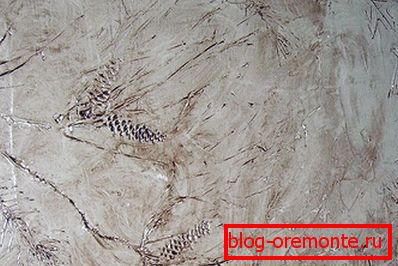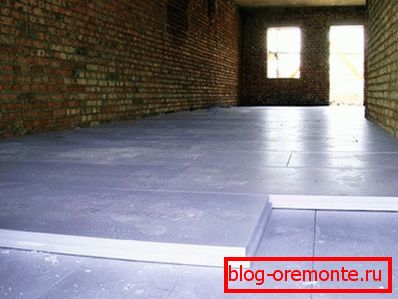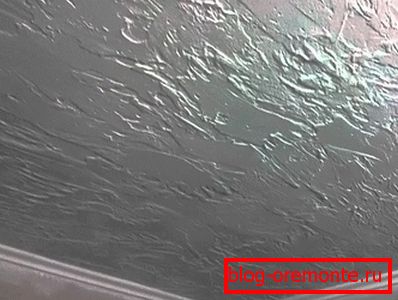Ceiling decoration with decorative plaster
The ceiling has a very important function in creating the interior, and using the appropriate technology and materials, you can drastically change the room. Finishing the ceiling with decorative plaster is one of the most common options used by modern designers, as it is practical, affordable and easy to implement.
Benefits and features

Unlike paints and wallpapers, decorative plaster has a number of advantages:
- Due to the plasticity and flexibility of this finishing material you can make absolutely any relief, which was conceived by designers. If there are cracks and defects, the applied layer of plaster can be removed and hidden from prying eyes.
- Manufacturers produce a huge range not only in the color range, but also with a relief surface. This allows you to create a surface in accordance with the idea and planning. In most cases, in specialized stores you can find white plaster, which can be painted in any color when using pigments. This will allow each consumer to create any shade.
- High performance properties confirm the strength and prolong the life. Minor mechanical damage (impacts) will not damage or damage the integrity of the surface. Decorative plaster applied according to all the rules withstands high air humidity, as well as temperature fluctuations in the room, which allows it to be used in the bathroom and in the kitchen.
- The main advantage of decorative plaster is the ability to apply it on any surface: wood, plastic, concrete, brick, stone, foam, drywall. Even if there are metal elements on the surface of the ceiling, there is no doubt about the quality of the result, since the applied layer is very well bonded with it.
Note! You can even apply decorative plaster on the painted surface of the ceiling. Care for her is just as easy: water and detergents.
Varieties

Each manufacturer uses in various proportions the basic components to create a decorative mixture, and also adds to them other, auxiliary, which improve the characteristics and properties of products. Today in the building stores you can find two types of plaster:
- structural;
- textured.
Structural plaster is presented exclusively in white, in which it is necessary to make coloring pigment. It is chosen by professional craftsmen, as for applying this finishing material to the surface it is necessary to possess certain knowledge and skills. Do not forget about a special roller, with which you can achieve the desired pattern due to the relief surface.
The textured plaster is already completely ready to be applied on the ceiling surface, therefore, it is chosen by apprentices who carry out finishing work with their own hands. The composition already includes all the necessary components, and the texture appears when applied to the surface. Depending on the size of the grain that forms the relief, you can find the following types of plasters in the shops:
- large-scale (3–5 mm);
- medium textured (1.5–2.5 mm);
- small-factor (0.5–1 mm);
- fine-textured (less than 0.5 mm).

In addition to this classification, decorative plaster may vary depending on the composition of the mixture:
- The main binding component is acrylic or polymer, which is dissolved in water at the production, as a result of which an environmentally friendly material is obtained.
- The use of epoxy resin or polyurethane allows the plaster to be durable and durable, but when heated, evaporation dangerous for the human body will be released from it.
- To create a smooth or rough texture on the ceiling surface, it is better to choose mixtures with filler from granite or quartz chips.
- A rough surface that is not resistant to abrasion will be obtained if the mixture with marble aggregate is selected.
- Manufacturers add special thickeners, antiseptics, preservatives to decorative plaster, designed for finishing the ceilings in the kitchen or in the bathroom.
Note! When applying a textured plaster of small or thin fraction, it is necessary to take into account that the surface should be flat and smooth. Otherwise, after performing the work, all defects will be visible.
Preparatory work

In order to get a qualitatively applied decorative layer of plaster as a result, you should first prepare the ceiling surface in the room. In the presence of irregularities and obvious defects, specialists use two methods for leveling ceilings:
- dry;
- wet.
In the first embodiment, drywall or other plates are most often used, and in the second, solutions and mixtures (gypsum, cement).
Note! It is possible to choose the way to level the ceiling by yourself, but experts recommend, when diverging more than 5 cm, to give preference to the dry version.
The technology of applying decorative plaster on the ceiling

Before you apply decorative plaster, read the simple recommendations. In order to conduct a high-quality application of decorative plaster on the ceiling, it is necessary to pick up all the tools that are needed and when finishing the walls. To fix the plaster layer well on the wall and press it to the ceiling surface, a rectangular stainless steel trowel is needed, which is well polished and will not change the pattern of the relief or disrupt smoothness.
Acquired structural plaster must be brought to a working condition by adding pigment to it, and simply mix the textured one. After that, you can begin to finish the ceiling with spatulas of different sizes, if desired, you can use relief types, with the help of which drawing and relief is done. It is very important to apply the plaster evenly over the entire surface, and the layer thickness should not exceed 5 mm, but should not be too thin (at least 2 mm).
Painting plaster, in which no pigment was added, can be done with special paints.
Note! A trowel with teeth will allow you to create a structured pattern: smooth lines or squares, as well as circles and waves. Using a coarse paint roller, you can create a rough surface.
Tips from experts

Over the entire surface of the ceiling should be used only one technology of applying a layer of plaster. Before starting work, it is necessary to wipe the entire surface of the ceiling with a soft and dry cloth to clean it from dust and dirt, and then prime it. It is only necessary to start applying the plaster after the primer has completely dried.
Any plaster mix should be thoroughly mixed with special equipment, but at low speed, as the grains can be damaged, which will lead to a change in the pattern. Movement should be smooth, as well as during puttying.
Note! On a properly prepared surface will not form a fungus and mold.
Today, experts use a huge number of techniques, thanks to which a unique pattern and texture is obtained on the ceiling surface. The use of various tools and materials will create a completely new surface relief.
Video
This video shows how to apply one of the types of decorative plaster on the ceiling: